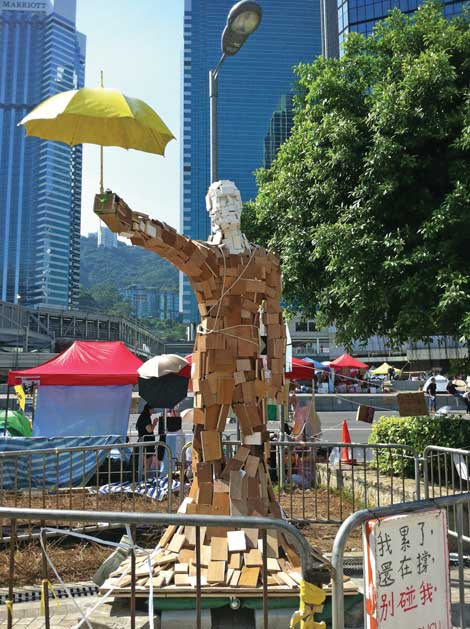When the Hong Kong police first used tear gas and rubber bullets on the crowd of young and unarmed demonstrators in front of the government building on Hong Kong island—the moment the so-called Umbrella Revolution started in earnest—I was just arriving in the lovely hutong hotel I would stay at in Beijing. The loveliness of my surroundings, a renovated traditional courtyard home in an old area of the capital, just enhanced the horror of that news given to me by my Hong Kong friends residing there. It would set the tone for the following days of interviews with young and older Beijing artists who all had something to say about Hong Kong, democracy and the sense of spite and exhaustion they felt about the domination of the Communist Party in every aspect of life and culture on the Mainland.
If 798 is the most fashionable “art district” of the capital—and it still contains major galleries and some studios—it is now more famous for its many restaurants and cafés and the atmosphere of sophistication it brings to the city. If you want to see more interesting art galleries and artists-run spaces in a place that still feels like it is lived in by “real” Beijing people, you should head instead toward Caochangdi. There, among others, we met a curator working in a gallery showing interesting photographers; this curator was of much interest to me because he had organized an exhibition on a political theme a few months before, an endeavor that tends to be increasingly dangerous in Mainland China. Asked if this show had been censored, he told us that the owner of the gallery was a tycoon CEO of a large insurance company—also married to a lady directly related to the family of Mao Zedong—and this may have been a guarantee that they would not be disturbed too much by the authorities.
This alone showed how unstable and unpredictable cultural life can be under the rule of the Communist Party. Most of these artists and curators tend to be very fatalistic about that situation: some factions of the party, like the one previously led by president Jiang Zemin and the “Shanghai faction,” tended to be slightly more liberal, if more corrupt; the present faction, led by Xi Jinping, are ruthless against corruption but tend to jail any pro-democracy activist at the drop of a hat and enforce a very strict, if just as unpredictable, rule of censorship. As a matter of fact, things are getting much worse for all kinds of art and culture, say many on the Mainland. A discourse recently given by president Xi Jinping, demanding artists to create art that is more about what “the masses” want, felt like the kind of rhetoric Mao Zedong would have used in the 1950s. The recent case of a friend of mine, a famous Hong Kong artist, reveals how strict censorship has become: just because he signed a petition in support of the Umbrella Revolution, he was immediately blacklisted and will not be allowed to come to Shanghai in November for the opening of the Shanghai Biennial where he will have an installation. But he considers himself lucky—as other Mainland artists openly supporting the pro-democracy movement in Hong Kong have recently been jailed.
For all its fantastic art activities and its still affordable environment (Ai Weiwei’s house and studio are there), Caochangdi is already a victim of its own success and the process known as gentrification is pushing younger artists away from that area. The newest art village of Beijing is therefore further away in a place called Heiqiao that still feels like the third world. There we met much younger artists—some of the most interesting and kind individuals I have met in China. The photos show some streets in Heiqiao where, next to a mechanical repair shop, you can already find some isolated galleries. But Heiqiao is more interesting for its artists’ studios (sorry, you have to know them personally to be able to visit: I was just very lucky to know a Hong Kong artist, former student of my art department at the Chinese University of Hong Kong, who has lived in Beijing for three years).
As we viewed their artworks, varying from painting to video and installations, conversations all veered towards the events of Hong Kong, events they were very familiar with (although Facebook is illegal in China, and it would be the only way to know what is really happening in the world for Mainland Chinese, it is not too difficult to have access to it once you know where to buy an illegal VPN connection). At some point in our discussions, one of the artists came back from his studio and offered an umbrella to my Hong Kong friend, asking her to bring it to the main demonstration site as a present from pro-democracy Mainland Chinese. They all signed it, and my friend was very happy to put the open umbrella in the occupied ground of Hong Kong. By then, the umbrella had become a worldwide symbol of the demonstrations and a potent image of the resilience of our very young demonstrators.
You will have noticed that I did not give any name—because all the persons mentioned in this article have shown support for the Umbrella Revolution, and since the paranoiac Chinese Communist Party has now ears and eyes everywhere in the world, I will not risk putting them in danger.













0 Comments